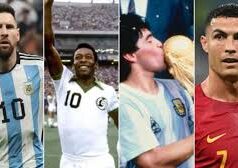By Rodney Ballantine
A little over ten years ago, Sevilla FC were in the second tier of the Spanish league and looking for a new resurgence to take them back into the elite of Spanish football and kick start their history again. That history started, by winning the Second division under manager Joaquín Caparrós and from there Sevilla would move into a decade where they would end their trophy drought which had lasted for fifty eight years, and in addition adding more to this one, ending a period of financial suppression and seeing the club take a deserved place among Spain’s and Europe’s elite.
Having won the second division trophy at the end of the 2000-2001 season, the club set about sustaining itself both financially and in terms of position within the first division. The club gained stability in the league, although it wasn’t until the sale of homegrown superstar José Antonio Reyes to Arsenal in January 2004 for an initial fee of £10.5 million where the wheels of change started to roll and gather speed. In the 2003-2004 season the team reached the semi finals of the Copa del Rey (Spanish cup), after a period of twenty years, as well as earning a ticket to Europe as a consequence of finishing 6th in the league and well, from there, things really started to happen.
The appointment of Juande Ramos, as manager at the start of the 2005 – 2006 season, lead to also an influx of quality signings that would turn Sevilla into a club that others needed to start to take seriously. These players included Andrés Palop from Valencia, Julien Escudé from Ajax, Javier Saviola from Barcelona, Luis Fabiano from FC Porto and Frédéric Kanouté from Tottenham Hotspur and these in turn would go on to play an integral part of the success of the club in the upcoming years. The team went onto win the UEFA cup in style in that year, by beating Steve McLaren´s Middelsborough by the biggest margin of victory in a UEFA cup final. Sevilla also beat Lokomotiv Moscow, Lille, Zenit st Petersburg and Shalke along the way. As a direct consequence of winning the UEFA cup they played the Super cup final as well, and managed to beat the then champion’s league holders Barcelona 3 – 0 and with it double their trophy haul in the space of three months.
A fifth place finish in the 2005 – 2006 season and the following season a third place finish, and with it champions league qualification, ensured that the team was progressing well on the Spanish stage as well as the European. There status in Europe also increased as the team again won the UEFA cup beating fellow Spaniards RCD Espanyol on penalties after a result of 2-2 after 120 minutes. This put them in the history book as only the second team in Europe to defend the UEFA cup title, etching their name alongside another great of European history, Real Madrid.
The beginning of the 2007–2008 season saw two events that would change the club, with one being one of the biggest emotional shocks that would take place in modern day football. This came from the death of the Sevilla player Antonio Puerta who suffered from a series of cardiac arrests during a league game against Getafe CF. This sent shockwaves throughout football, and as a mark of respect Sevilla gave one minute of silence at every home game for the rest of that season. They also tried to retire the number sixteen shirt but the rule that La Liga clubs cant retire shirts numbered one to twenty five, meant that this was not possible, and as a consequence they give the shirt to Dsvid Prieto, although now it is worn by Diego Capel. Sevilla fans also show their respects, by clapping throughout the sixteenth minute of every game, because of the number sixteen that was worn by Puerta, at the time of his sudden death.
As well as this, Sevilla, would lose someone else who was instrumental in their success of recent times. Manager Jaunde Ramos would resign from his post to take up a rather unsuccessful stint at Tottenham Hotspur of England and leave behind a legacy of being the most successful Sevilla coach of recent times. He would be replaced by Manuel Jiménez Jiménez and this would in turn lead to two more managers in the following years.
The last few years have not been as successful as those earlier on in the previous decade, although the team did manage to win the Spanish cup the last year. They seem to be going through a transitional phase at the minute, and their league position seems to be consolidating this theory, with the team stagnating around the sixth to tenth position this season. New players have been coming in, and the players who have been pivotal in the success of the team in the last few years, seem to be on the way out, among those, Luis Fabiano, who is constantly linked with a move, and has publicly declared his intention to do so, in the last week. It seems the good times have passed, and the next stage being in its early days, although the team now, has more of a base from which to improve on, than that earlier transitional period at the beginning of the year 2000. Heres hoping that success will prevail again, for this wonderful city and its team.





